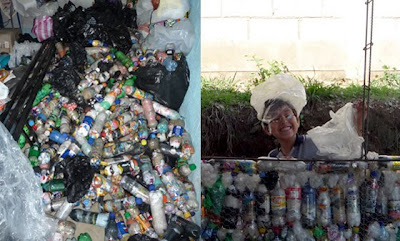All photos courtesy: Laura Kutner
Talk about inspiration. Peace Corps volunteer Laura Kutner (a 2002 graduate of Portland's Lincoln High School) was in Granados, Guatemala and saw two problems. Laura decided to turn these problems into challenges and do something about it.
The first challenge Laura noted was an abundance of plastic trash – bottles, bags, chip bags, candy wrappers to name a few. The other challenge was that she noticed that students had to attend classes in schools with no walls. The school’s principal told Laura that the local government had run out of money before finishing the school. The local people really needed the space for the school children and other community gatherings; so, the principal asked Laura if she could help.
Laura looked to Pura Vida for an answer. Pura Vida is an ecological movement in Guatemala that tries to find new ways to use trash. They look upon themselves as an “Ecological Movement of an Alternate Trash Management”; and, have developed a way of incorporating used pop bottles and trash as construction materials.
"A bottle project had never been done with metal before, always out of wood, but I figured why not look into it," she said.
With help provided from Hug it Forward; and material and labour from local businesses and villagers, the school project began.
The team started by collecting trash – plastic grocery bags, chip bags, plastic bottles and any other plastic waste they could find. Laura says, "First of all, there is so much plastic. Everything is packaged in plastic. I got so sick of plastic."
She and the agricultural community of 900 people with the help of surrounding mountain villagers collected more than 4,000 used plastic drink bottles from ditches, gutters and trash piles. This does not include all the other trash they collected to use for stuffing the bottles and the walls.
After the garbage was collected, they began the real work - stuffing the plastic bottles full of other trash. As many as 250 pieces of trash were crammed into each bottle using hands and sticks. Stuffing the bottles served two purposes: it contained the plastic trash while adding heft to the bottle structure taking shape.
"We all got blisters from stuffing," Kutner said.
Then they placed the bottles into the chicken wire mesh fencing stuffing more trash into the spaces between the bottles; and, the spaces between the bottles and the fence.
Laura said: “We needed A LOT of plastic trash. If the empty spaces weren't stuffed with trash then it (the cement) flew right through to the other side when we threw the cement on. We used so much trash that we could not find anymore in the town and had to go to neighboring villages to get some of theirs. It was awesome!"
After the fencing was stuffed with the waste, three layers of cement were placed on each side. At first the bottle-filled chicken wire served as a support for the cement to cling to. Once the cement was dry it created the look and stability of any other wall with the bottles now serving as insulation.
The orange building is the completed school—the bottles are inside the wall. Unless someone told you – would you be able to tell the difference between these walls and other “traditional” walls? I wouldn’t. What about the cost? This school was erected for the sum total of $3,000.00. Amazing what $3,000.00; a ton of trash; willing, joyous volunteers; and, some good old ingenuity can do.
Laura called the project "truly the perfect example of a team effort. If the entire town had not participated, it would not have happened!"
Beside the noticeable lack of refuse on the ground after the project, Laura noticed that the community also got a new awareness of litter and its possibilities.
Kutner recounts an experience she had while on a bus. It was the first time she heard a mother tell her child not to throw an empty bottle out the window. Until the school project this had been a common practice. Another resident has begun collecting cans and hauling them into the capital, four hours away, to collect the deposit.
Laura describes her work: "I miss my family; but, I feel like I come alive when I do this kind of work."
Short video showing the building of the schoolhouse by a series of photos.
or this one - quite similar; but, worth a look.
What a spirit those villagers have. The look on those children's faces showed the joy they felt at being able to help build their schoolhouse. Students in developed countries should be so happy to learn.
Via Planet Green and Oregon Live.com









No comments:
Post a Comment